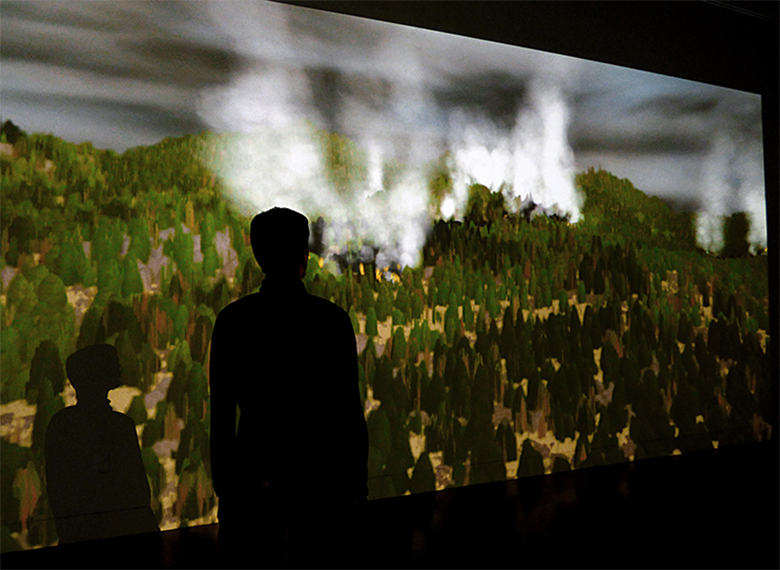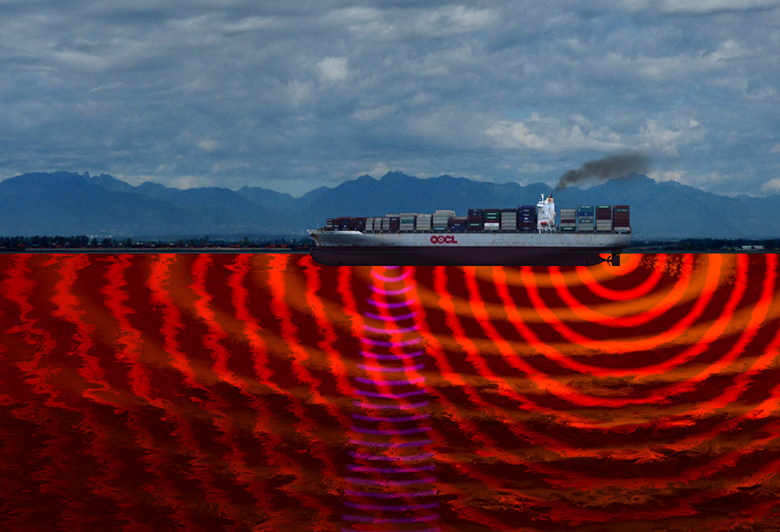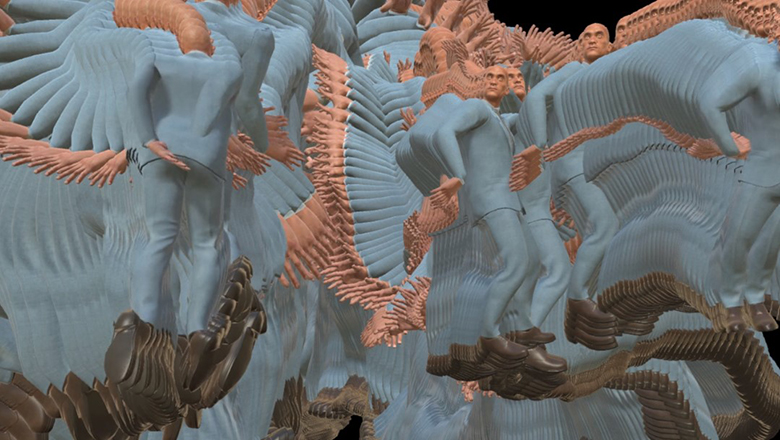Materiality and our relationships with objects in our world are important not only from an artistic standpoint, but also because they challenge our relationship with the Other, whether the Other is nature, object, animal, or human. Due to its material ambiguity, media art has a unique relation with software and hardware, as well as the materials it represents. The code, the objects it references in the real world, and the interaction between the viewer and the digital world that is created by the code become the material of artworks.
Victoria, BC based artist Colton Hash’s work deals directly with the data produced by the physical world and reflects it in a digital space. The relationship he creates between physical, data, and digital representations deconstructs the binary between the natural and technological, as well as our notions of good and bad. In the dynamic-interactive digital installation Homeostasis (2018), the viewer can interact with the forest environment by putting out forest fires, however, this intervention from the viewer disrupts the natural balance of the forest, and rather than stopping the fires, only causes them to burn more intensely. The viewers’ interactions accumulate over time, changing the outcome of the work, which left to its own devices has fires that burn and go out creating balance over time.
These interactions mirror our own relationships with nature where the unintended consequences of human intervention often cause repercussions that are unforeseen. Homeostasis gives viewers a way to reflect on our interactions with nature. Although not perfectly reflecting the complexity of nature, it drives our curiosity to think about our roles in the world in new ways. Rather than think about humans as separate and controlling of nature, we can think about our interactions as being thoroughly integrated with nature, and our role within it. This work also asks us to consider actions as not solely good or bad, but rather as nuanced. While forest fires can be exceptionally disruptive to human activity and cause a myriad of emotions, they are also an important natural process for the forest. Homeostasis implicates the viewer within this natural cycle by allowing them to intervene in it, although this intervention, much like those in the physical world, can have unintended and negative ramifications.
Hash’s Acoustic Turbulence (2019) also mixes the physical and digital by using the Unity WebGL platform to allow viewers to interact with hydrophone data from Ocean Networks Canada.1Although the interactions are less complex than in Homeostasis, the viewer can choose to hear the sounds created by various boats underwater or ignore them by remaining above the surface. This can be seen as a metaphor for our interactions with ocean noise pollution in the physical space, as it is an easy problem to ignore. Interaction in this work is key to its understanding, if the viewer chooses not to interact with the work, the meaning remains hidden. The rendering of the boats and the ocean themselves is representative of their physical properties, exposing an unseen aspect of our interaction with the ocean, the sound created below. The platform that the work is created in creates limitations and opportunities for interaction with the viewer. These interactions in turn consider the complex interactions that we have with our environment and how these interactions are mediated through technology. Rather than creating a nature as good, human activity and society as bad binary, these works ask us to consider the daily interactions that go unnoticed.
Although often tucked away behind walls or out of sight, the digital is in fact not immaterial.
Because of Hash’s focus on the natural world and our impact on it, Acoustic Turbulence and Homeostasis lead us to think about the materiality of the digital and the ecological impact of artworks. Although often tucked away behind walls or out of sight, the digital is in fact not immaterial. The minerals needed to create processors and the energy used for servers for cloud computing is the material behind the visible aspects of the digital. These materials are not benign, and often involve detrimental mining practices and the use of large amounts of resources. Much like the sound waves of Acoustic Turbulence, these materials are hidden just out of sight. As NFTs2and other digital technologies become more present in the artworld, their ecological impact becomes more relevant and should be considered not as inherently good or bad but rather in their full complexity. Art, digital or otherwise, impacts our environment, and we must consider both the benefits and disadvantages of our choices of materials and their full life cycle.
Dr. Paul Leonardi, professor of technology management, suggests that digital artefacts and artworks are significant because they create a relationship between people and things.3 He defines the difference between concept and material: materials have constraints, certain materials do certain things, whereas concepts do not have these limitations. This is a productive way of thinking about materials in the digital space and suggests that different digital platforms are made of different materials. Although conceivably both made using html, JavaScript, or other shared coding languages, a website and a virtual reality platform have significantly different constraints, and therefore are made of different materials. We should think of media art as being not only made of a uniform material, like a code, but instead look at the combination of code and the platforms as a whole to consider what constraints are being created and how the artist is using the materials to create interactions.
The concept of New Materialism4opposes the Cartesian dualisms in particular those of natural/man-made, subject/object and mind/body.5The dominance of a Cartesian separation of the sensual and the psychological has molded the ways that we think about artwork, and often causes a perceived disconnect between bodily experience and digital artworks. We are led to believe that if we cannot touch something then it is not real. This is a misreading of the materiality of media arts as the screen itself, rather than the code and interactions that lay behind it. It implies that our senses and mind do not affect and give information to one another: that there is a truly mental experience separate from that of the body. We tend to read what we see as natural (pigments, oil, charcoal) as fundamentally different from that which is technological (phones, projectors, monitors). However, this dualism is false. Computers are made of minerals just as oil paints are, and neither would exist without human intervention.
This notion that our technology is fundamentally different from other materials shapes the way we interact with it. The common way we often classify nature as good and the technological as bad reflects long standing and problematic ideas of the “noble savage” and the corrupting nature of society that come from Rousseau.6 This view that things which are untouched by “civilization” are inherently good colours our view of technology and media arts, even if unconsciously. This is because of our interactions with the technological aspects of media art in our everyday lives; our phones and screens have become both vital to our lives and often an unwanted intrusion in them, causing us to feel isolated from each other in a world with high levels of this particular manifestation of connectivity.
Similarly, we cannot separate media art from the connotations of other digital media, especially television, film, and video games. When we encounter media art, we associate it with other media we are familiar with. For example, we expect narrative like in a movie, although this is not always forthcoming in new media works. We also consider the objects that we experience in the digital space in relation to those in the physical world. The way that we interact with representation of objects defines how we feel about those objects in the physical world. When we are asked to think about and interact with objects differently than in both the physical world and from other media that we engage with, this pushes us to consider the specificities of media art, and more importantly what is interesting about it.
How can we engage with media art in ways that are different from other artistic media and other uses of the digital media, such as non-artistic uses of social media? In what ways does media art ask us to consider how our relationships overlap between the physical and digital? These questions are both hidden and at the forefront of media works. We interact with screens and digital spaces in many ways throughout our day, whether it be a Zoom meeting, social media, video games or email. How does our participation in media art differ from these other media interactions, and other artistic interactions? Does the material of the digital world change how we conceive of it in this context?
Winnipeg, MB artist Freya Olafson’s work addresses these questions through an exploration of the body as material. Olafson uses the physical body and digital representations of the body to interrogate how the body can be used as a material, and how the digital representation of the body is both the same and different from the body in physical reality. Their works also draw attention to how representations of the human form have ethical implications: how we are represented changes the ways we interact with and understand each other.
The digital representation of the body is not the same as a person in the real world, so how should we treat the digital Other?
In their 2019 work VR Commodity Manifesto, Olafson considers how the physical is translated through virtual and augmented reality platforms. The video is a collage of clips taken from various VR experiences, starting from those which seem reasonably benign, such as an avatar dancing, and views of interesting landscapes to seeming more concerning images, that appear to be the manipulation of the human form. While the clips are playing a text to speech program reading a manifesto which hints at the ubiquity and spread of this technology. The shift from lighthearted images at first to more disruptive images imply the possibility of a sinister use of the technology. This video work reflects on the ethics of our interactions in virtual spaces, and the ethical implications of simulacrum in these media. The digital representation of the body is not the same as a person in the real world, so how should we treat the digital Other? Does the fidelity of the representation matter and what are consequences to our digital interactions that go beyond the virtual? It is possible that the way that we interact with these representations has an impact of how we interact with people in our physical life. Olafson notes in her description of VR Commodity Manifesto that there are very little regulations about what can be depicted in VR and AR, and this has led the European Union to create a code of ethics for VR production.7
Does the possibility for resemblance to the physical world require us to think about our interactions in XR differently than other media? These questions are especially difficult when thinking about the way that humans are often depicted in virtual reality spaces, both as sexual objects, and in war simulations. We know from traditional media such as film and television that the way groups are depicted can have real consequences on their daily lives.8 What is less considered are the consequences of depictions of the digital other, where the uncanny digital likeness is both like and unlike us. The VR Commodity Manifesto asks us to consider these questions through a mash up of images from AR and VR, some benign and some strange and off putting.
In Disembodied Beings (2019), Olafson contemplates the relationship between the corporeal and digital body by mirroring a video of a physical person with the movements of the avatar, overlaid with an audio description of astral projection.9This draws our attention to whether the digital is just a continuation of our physical selves, a disembodied being. The digital version glitches in and out as does the video of the person, causing, at moments, for them to dissolve into each other, or one to completely obscure the other. As the video continues the person controlling the avatar is no longer seen within the video and there becomes multiple avatars instead. These avatars mainly represent women, and often their bodies are highly stylized and sexualized.The audio suggests a potential sense of freedom or terror may be experienced as we project ourselves outside of our bodies, “it depends on the person, it can be a freeing experience” as well as describing the feeling of having no pulse which can be “scary”. This uncanny space between reality and the virtual suggests a mirrored reality. We should therefore treat the digital other ethically, as though our obligations to them were the same as to the other in the physical world. This means interacting with the digital other as not as instrumental, an object to be manipulated, but as a subject who has agency, that can change us and be changed by us.
In the 2017 video installation Painting with the Man, Olafson questions the instrumentalization of women’s bodies in Yves Klein’s 1962 Anthropométries series where he covered women in his patented blue paint and made prints of their bodies. Olafson reverses these roles, having two suited men create the marks on the digital screen. These men are controlled by Olafson wearing a motion capture suit which creates multiple impressions across the screen. The male figure is a generic “ready-made”, a pre-existing digital form that exists on the internet, reflecting how the women in Klein’s work were interchangeable, a mere paintbrush. The audio furthers the uncanny nature of the men’s movements and limbs that bend in unusual ways. This strangeness reminds us that this is merely a representation, rather than an actual body. Painting with the Man folds in multiple layers of understanding, that of Klein’s original instrumentalization of the women in his work, the relationship between the physical and digital body, and how positions of power change our understanding of the use of the body in artwork. The digital men in Olafson’s work lack agency in the same ways that the women in Klein’s work do; this connects the objectification of the body in the physical world to that of the digital one.
Both Olafson and Hash question how we interact with the other. Hash asks us to consider the natural landscape as other and Olafson asks us to think about the human other: how we affect the objects in our environment and are affected by them. The digital gives us separation from the subject to consider how we act ethically towards the other, even when they are not human. New Materialism also similarly asks us to consider our ethical responsibility to the non-human other.10 We are asked to respond to the other, to have response-ability.11
Olafson and Hash interrogate how we see and respond to the other in the digital space by referencing the relationship between the physical and the digital. Our interactions with the materials of media art have multiple dimensions, through the screens and interfaces, as we interact with the code, and as we connect what we see with the objects in our physical space.
The nature of materials in the digital space and media art becomes more imperative as we spend more and more time interacting with the digital world, not only in art practices, but also in our daily lives.
Colton Hash’s exhibition Fractured Waves hosted by Artcite Inc. will be online until March 31, 2022. Hash is a finalist for the Salt Spring National Art Prize which holds an exhibition of its finalists September 24 to October 25, 2021.
Freya Olafson has been longlisted for the 2021 Lumen Prize for Art and Technology. Olafson will also be a part of a SummerWorks Lab virtual residency.
For more information about the artists:
Colton Hash: https://coltonhash.com/
Freya Olafson: https://www.freyaolafson.com/







